Crassula capitella
Crassula capitella is a dramatic foliage succulent plant which has branching herbaceous stems with colorful, thick leaves with serrated edges. A cluster of lightly fragrant starry white flowers grows on the leaf surfaces during the blooming period preferably in the summer season. Their eye-catching fleshy, spectacular leaves have made them a perfect example for a foliage plant.
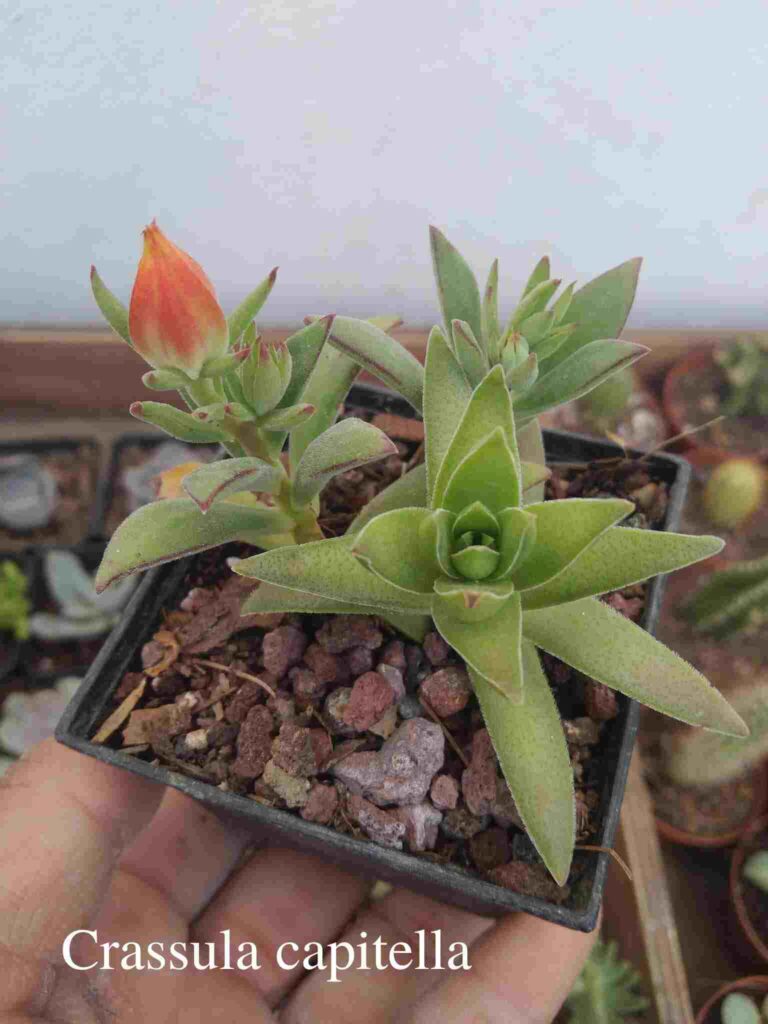
Crassula capitella are tropical, evergreen and perennial succulent, planted mostly outdoors in rock gardens, hanging baskets or as ground covers and indoors as houseplants. They can spread about 12”-36”(30-90cm) in width, therefore are planted with a spacing of about 24”(60cm) to let them spread. Their stem length ranges from 6” to 8”( 15-20 cm).
People are still in a dilemma regarding the toxicity of Crassula capitella. However, their relative houseplant called Jade plant is poisonous to pets and humans when ingested. So, there’s a high chance this succulent is also poisonous and reports have shown that people who ingested the leaves developed diarrhoea. They are native to Southern Africa and their cultivars are popularly grown on eastern cape of South Africa. They are considered a rare succulent and are moderately invasive species. They are grown in USDA hardiness zones 9 to 12.
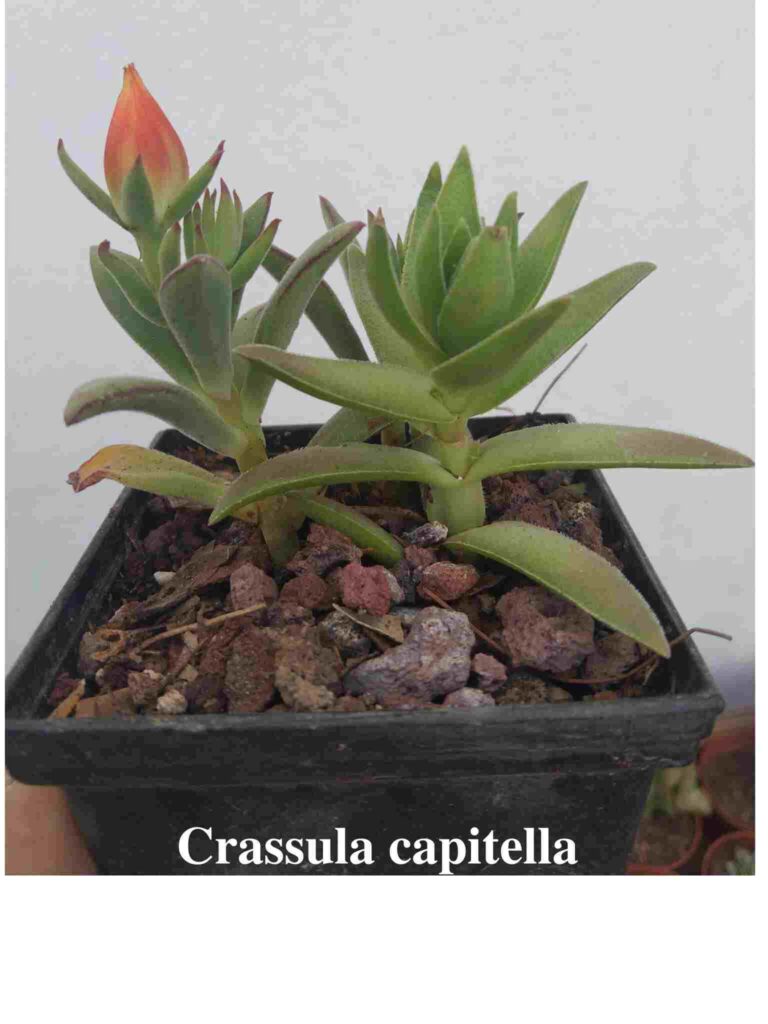
Crassula capitella are known by different common names like Red pagoda, Pagoda village, Campfire, Red flame, Shark tooth, etc. These plants are popular among the succulents mainly due to their fascinating shiny leaves. They can create a colorful mat or ground cover giving the garden an artistic, unique and attractive appearance.
Crassula Capitella Campfire
Crassula capitella Campfire is a biennial, monocarpic widely spreading succulent with fleshy propeller-shaped leaves arranged alternately. They are named due to their leaf resemblance to campfires with red flame. Their leaves are longer and thinner than other cultivars. The shade of their leaves changes when they spend more time in sunlight.
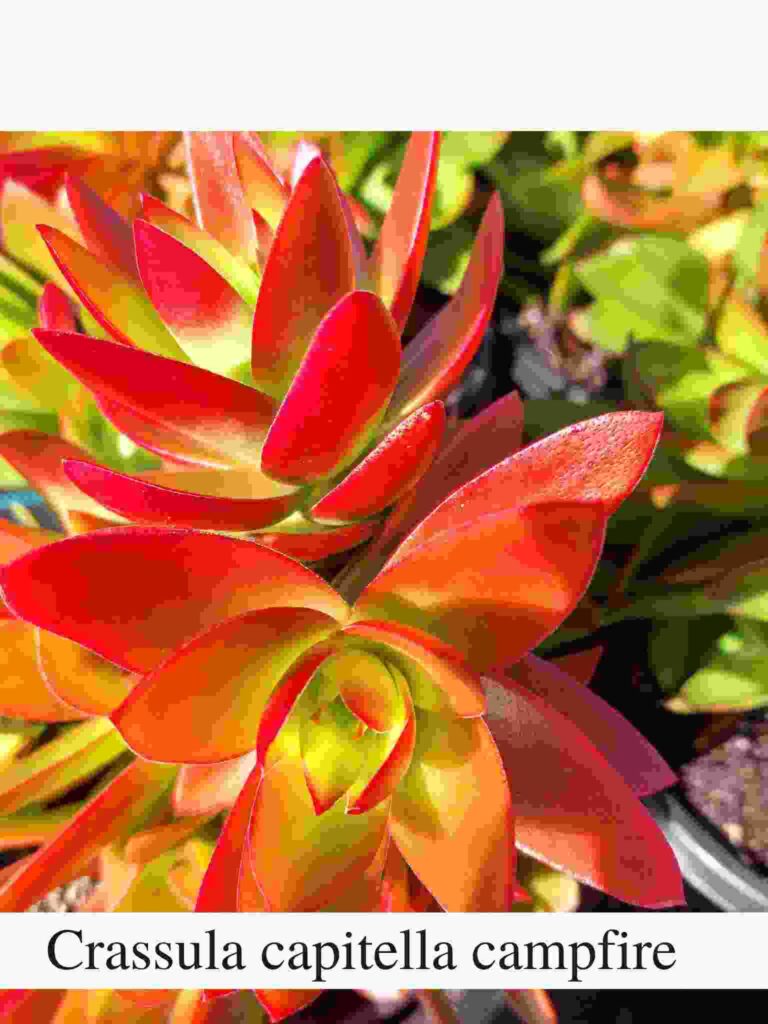
They start off with light green and gradually move towards pale pink to brighter pink and eventually bright red under full sun on maturity. They are kept under the sun as long as possible to retain their brilliant shade. This succulent can grow 6”(15cm) tall and 3 feet(90cm) wide turning into a beautiful colorful mat. Thus, they can cover a fairly large area when grown untrimmed.
Crassula Capitella subsp. Thyrsiflora
Crassula capitella subsp. thyrsiflora, commonly called Red pagoda, is a branching perennial succulent with fleshy, triangular leaves decorated with crimson tips densely stacked upon each other in a pagoda style. The rosettes are formed by the overlapping of smaller leaves over the bigger ones towards the tip. They shine brightest in response to cool nights and bright sunlight in the winter season. They can grow up to 8”(20cm) in length and 18”(45cm) in width.
 They can form a small scale colorful mat on the ground surface. They are a low growing variety compared to others. So, they are widely popular for hanging baskets and containers. The four columns of triangular leaves on increasing order stacked upon each other gives a spectacular and satisfactory view from the top. The leaf shade goes from chartreuse at the bottom to dark red or crimson towards the apex. They spread by runners to form small colonies.
They can form a small scale colorful mat on the ground surface. They are a low growing variety compared to others. So, they are widely popular for hanging baskets and containers. The four columns of triangular leaves on increasing order stacked upon each other gives a spectacular and satisfactory view from the top. The leaf shade goes from chartreuse at the bottom to dark red or crimson towards the apex. They spread by runners to form small colonies.
Also Read:
Alocasia Sinuata: Care And Propagation
Monkey Tail Cactus: Care and Propagation
Crassula capitella subsp. Thyrsiflora ‘Pagoda village’
Pagoda Village is a rare succulent with tightly stacked triangular leaves. They have red, purple and green shaded leaves. They can grow 10”( 25cm) tall. They bloom from mid-summer to early fall and produce tiny pink or white flowers.

Their leaves are flatter and they grow a bit downward than Red Pagoda species. They grow through runners and stay in big colonies. Unlike the bright leaves of Red Pagoda, their leaves are quite darker in comparison and thus, are preferred by dark shade lovers to decorate their space.
Botanical Classification
Kingdom: Plantae
Clade: Tracheophytes
Clade: Angiosperms
Clade: Eudicots
Order: Saxifragales
Family: Crassulaceae
Genus: Crassula
Species: capitella
Care
Crassula capitella are easy to grow if certain conditions are taken into consideration. The soil moisture plays a vital role in the growth of this succulent.
Light
When Crassula capitella are grown outdoors, 6 hours of sunlight a day is considered ideal. These succulents can grow well under full sunlight as well as partial sunlight. They are placed at the window area that receives bright sunlight 3 to 6 hours a day when kept indoors. The best leaf coloration is obtained in the full sun although they need some shade protection from midday heat. Under shade, the leaves remain bright lime green and get leggy. Exposure of plants to full sun directly from the shade may lead to sunburn.
Temperature
These succulents thrive in average summer temperatures between 30°F (−1.1 °C) to 50°F (+10 °C) degrees. Exposure to temperature below 30°F (−1.1 °C) can damage this succulent. An intermediate greenhouse or indoor conservatory should be prepared at places highly prone to frost. Crassula capitella can tolerate light frost but can’t tolerate freezing temperatures. Heavy frost may lead to scarring of plants. Thus, they should be kept indoors throughout the winter in cold zones.
Water
Crassula capitella are drought tolerant plants. They need a moderate amount of water. Watering can be done weekly at regular intervals. However, it should be done more often during extreme heat conditions. The soil should be completely dry before watering. They are highly susceptible to root rot and fungal infections if immersed in water for a longer period. When temperature decreases, watering is decreased eventually during winter.
Soil
Well-drained, nutrient rich, gritty soil is highly recommended for this succulent. Sandy, loamy soil and potting mix of pH 5 to 5.5 is preferred. The soil can be moist but not wet for extended periods. There should be good circulation to remove excess water.
The dryness of the soil can be measured by dipping your finger into the soil mix. Absence of soil particles on the finger indicates dry soil and watering is done. The extra undrained water should be removed if soil is completely wet. Porous, well aerated, light-weight soil ensures sufficient supply of oxygen and helps in respiration as well as proper growth of the roots.
Fertilizers
The fertilizer specially formulated for succulents i.e. with low nitrogen, including different micronutrients and trace elements are fed to the plant every 4 or 5 weeks during blooming and rapid growth phase from mid spring to early autumn. Diluting the fertilizer to ½ the strength increases its efficiency and prevents overdose. The feeding is stopped during winter.
Potting And Repotting
The pot should have drainage holes and should be able to allow excess water to flow out of the soil. The potting mixture should be friable, well-draining and organic soil rich in nutrients. Sand and perlite can be added to improve the quality of mixture. The propagated part is planted at the center and watered thoroughly. It is exposed to full sun only after rooting.
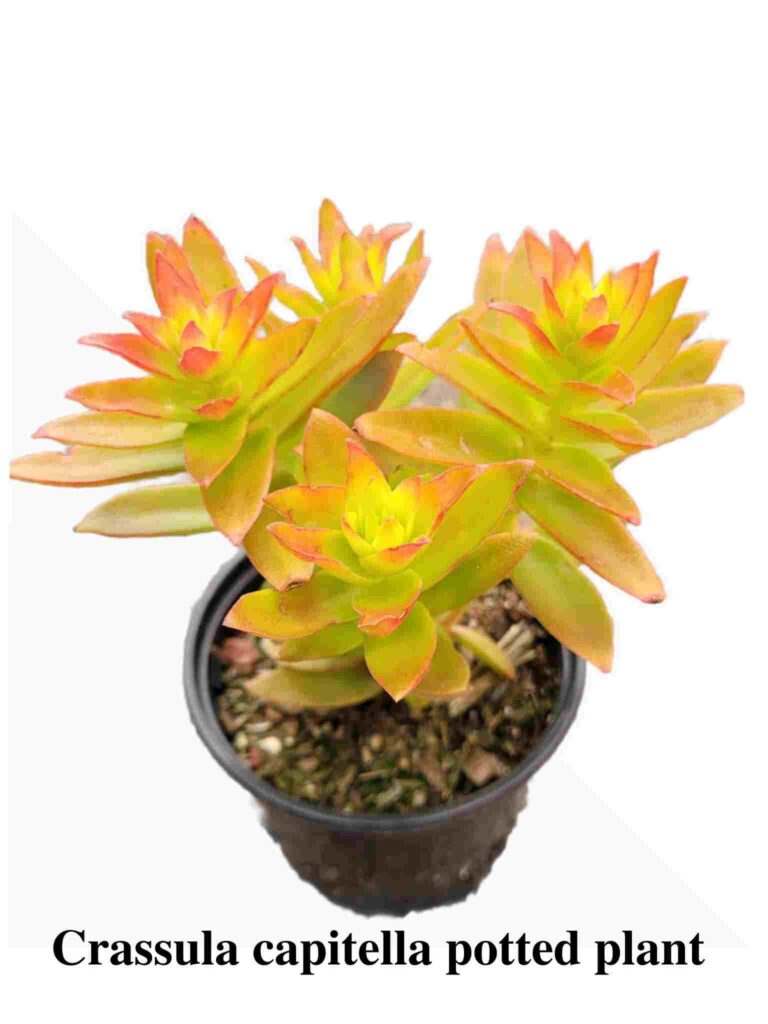
Repotting is done every 2-3 years in early spring when nutrients in the soil are depleted and the plant needs more nutrients during the rapid growth phase. About 10 percent of the root ball is cut off, infected leaves are removed and fungicide is applied on the infected part before placing it in another pot.
Propagation
Crassula capitella can be propagated by seeds, leaf-cuttings and stem-cuttings. They can be propagated by offsets as well but it takes several years for a mother plant to produce it.
By Seeds
- The seeds are directly sown on the prepared potting mixture. The pot is then kept in the place you want, maintaining ideal conditions.
By Leaf cuttings
- About 5 inch long leaf is cut using a sterilized blade or scissor. The leaf cut is left to dry in shade until it gets callused. It is then simply sown on the potting mix.
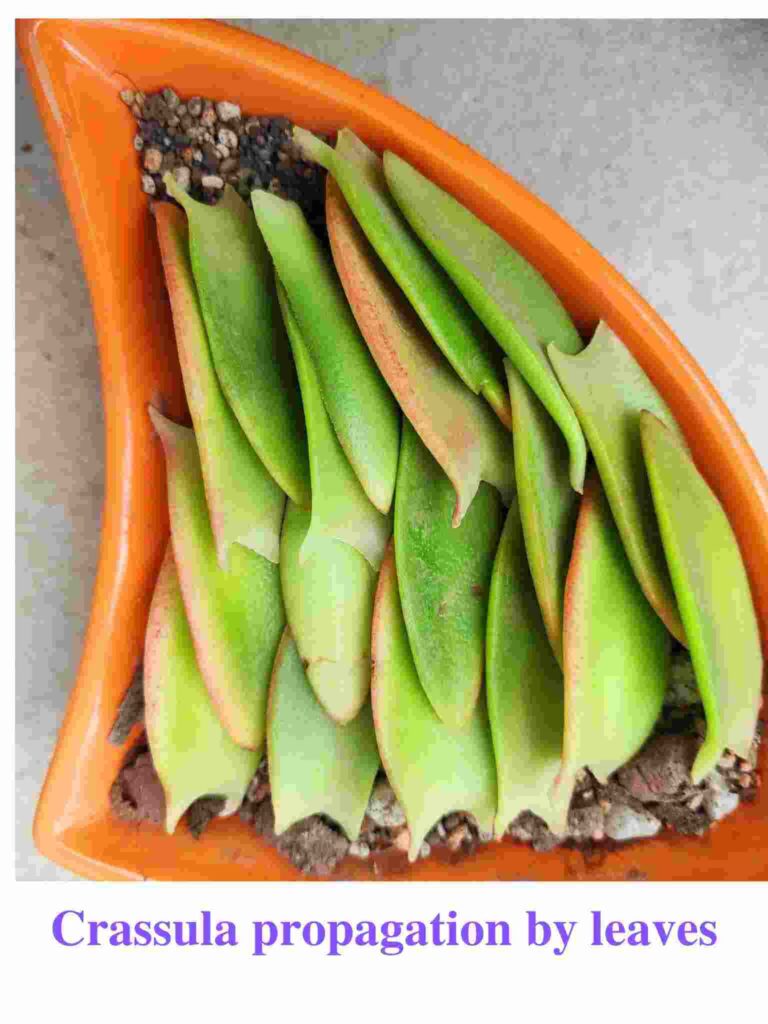
By Stem cuttings
- About 2 to 4 inches long stem having at least 2 internodes is pruned.
- The leaves are removed and the stem is kept under the shade over potting soil until they develop calluses.
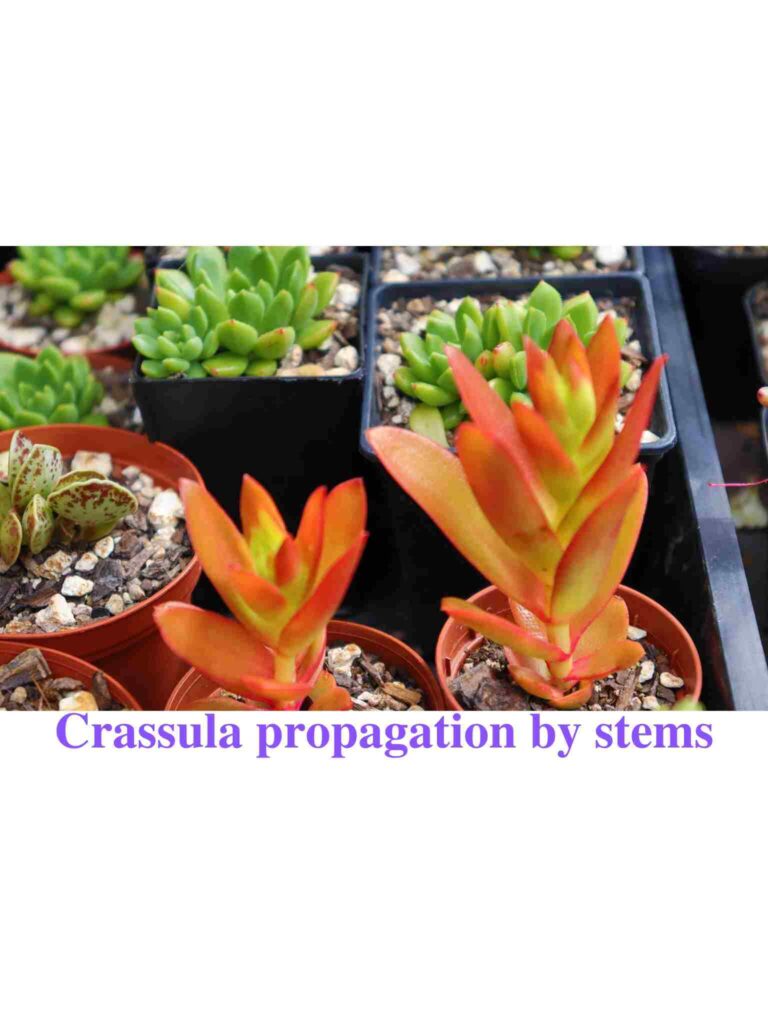
- The callused stems are then inserted inside the dry potting soil and placed on the place with indirect sunlight.
- Light misting is started after a fortnight and watering schedule is maintained according to the environmental conditions they are grown on.
Common Problems
- It may suffer from foliage edema due to rapid change in moisture. Right soil and good watering process should be promoted to control moisture.
- Root rot due to overwatering is a major problem among Crassula capitella species.
- Brown spots can be seen on the leaves when temperature goes below the freezing point.
- Mealy bugs: White cotton-like fuzz appears on the stems and leaves when this plant is affected by mealybugs
They can be removed by rubbing the affected part with alcohol using brushes. The crab-like insects should be dabbed off from the plant.
Pros
- Used as beds and borders in gardens.
- They Grow well in patios and containers.
- They make a beautiful rocker plant in dry areas with high temperatures.
- They can be captivating ground covers.
Cons
- Difficult to control moisture level.
- The extra water should be removed if it’s not absorbed by soil to prevent rot.
- Since the leaves are stacked, it’s difficult to identify infected parts and remove pests.
- They need light for a long period to turn bright red which is difficult indoors.
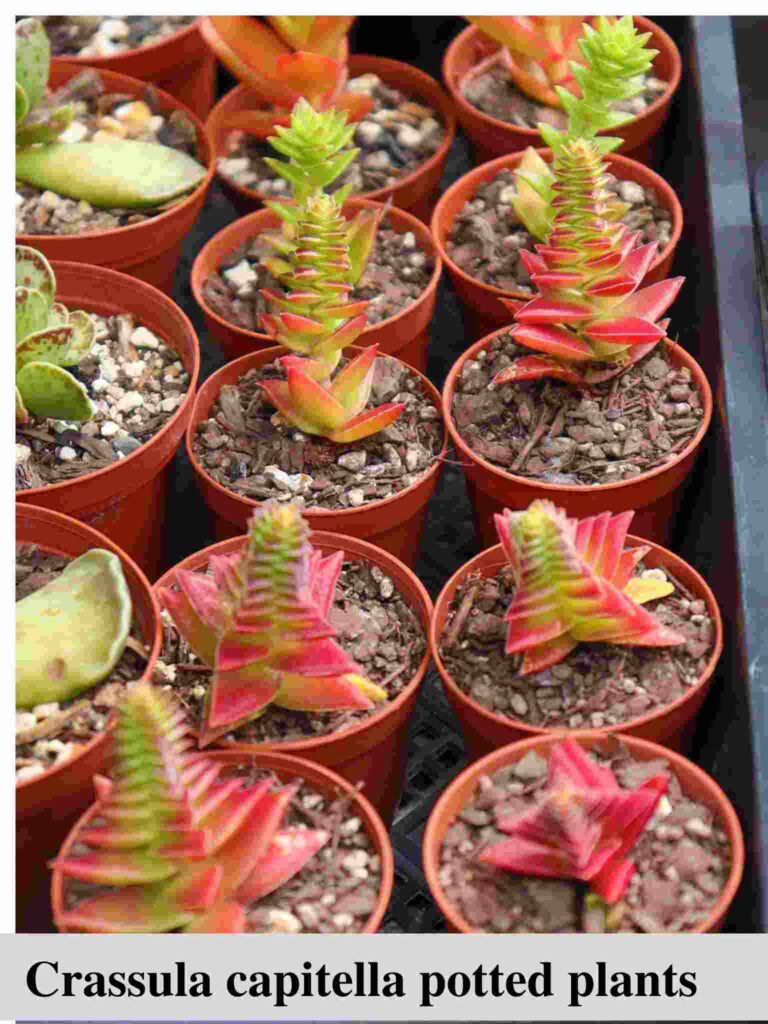
Conclusion
Crassula capitella is a wonderful, unique succulent and best foliage plant to decorate your garden or rocky landscape under ideal conditions. One should be able to distinguish when to water and maintain proper moisture. Otherwise, root rot can damage your plant. It is recommended only if you can manage time to take proper care of it. Planting this succulent is a high risk for the ones with pets due to its possible toxicity. Overall, it’s definitely a good to purchase to create an exceptional landscape view.

